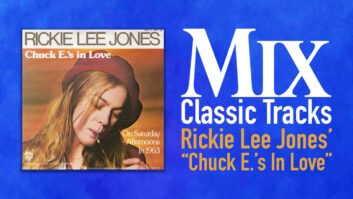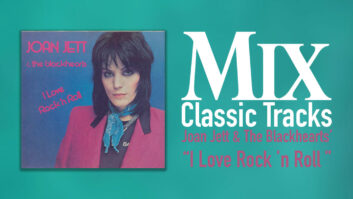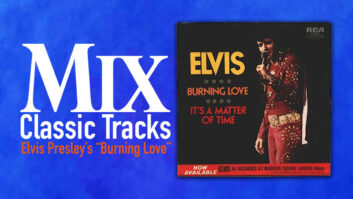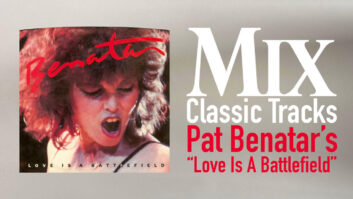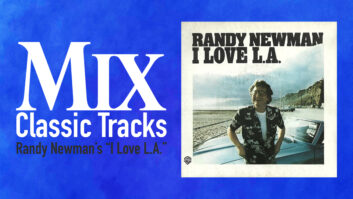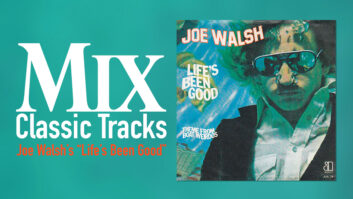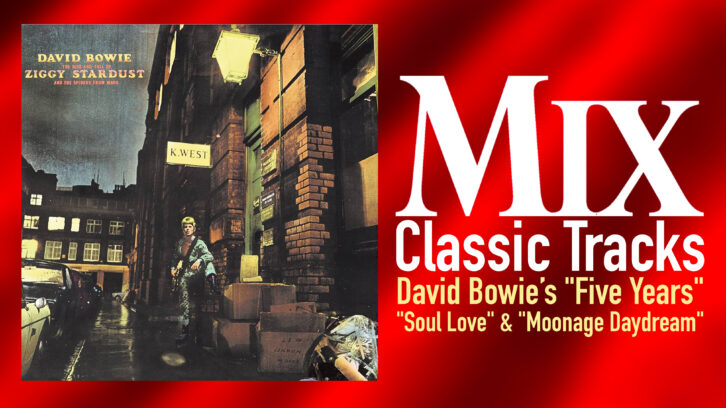
Much has been written about the importance of David Bowie’s album Ziggy Stardust & The Spiders From Mars. His fantastical creation of a futuristic, androgynous rock star named Ziggy and the album’s utterly unique-sounding songs influenced the look and music of many artists after its 1972 release—from Queen, Suede and Mott the Hoople to Lou Reed, The Cars and Elton John. Not only did Ziggy Stardust establish Bowie as a major talent, it also cemented Ken Scott’s reputation as an important producer with a unique sonic and artistic vision in the rock world.
A few years prior to making Ziggy Stardust, producer/engineer Gus Dudgeon had invited Scott to leave Abbey Road and work at nearby Trident Studios in London, one of the hottest new facilities in the world at the time. It was there that Scott’s working relationship with Bowie started, during the making of the artist’s Tony Visconti-produced Man of Words/Man of Music album. (That album was later released in the U.S. as Space Oddity and featured the hit by the same name.) At the time, Dudgeon’s own production career was just beginning, too.“David was working with Tony on the album, but Tony hated the song ‘Space Oddity,’” Scott says, “so David used Gus for that one song and Barry [Sheffield] engineered it. I ended up doing all the other songs on the Space Oddity album.”
The album that preceded Ziggy Stardust was Hunky Dory, which eventually featured the artist’s first real stateside hit, “Changes.” It was Bowie’s debut on the RCA label and his first production with Scott. It is hard to only address Ziggy Stardust without some mention of Hunky Dory, as both albums were recorded back-to-back within a several month period. “We recorded Ziggy before Hunky Dory was released,” says Scott. “Ziggy was recorded a month after Hunky Dory. I think it was while we were recording Ziggy that they actually signed the deal with RCA.”
Ziggy Stardust was recorded over a two-week period during November 1971 at Trident, which was located in the Soho area of London. In this era, Trident was home to many high-visibility projects for artists such as The Beatles, T. Rex, Elton John and others. The Ziggy sessions would usually run from two in the afternoon to just past midnight, Mondays through Saturdays.
There are a number of songs off of Ziggy Stardust that warrant “Classic Track” treatment, including the pile-driver rock of “Suffragette City,” “Starman” (the album’s single) or the dramatic sweep of the title track. Nevertheless, Ziggy‘s opening triptych of “Five Years,” “Soul Love” and “Moonage Daydream” is one of the greatest opening sequences ever committed to vinyl. The three songs, seamlessly linked together, are not only some of Bowie’s best work, but they provide the emotional thrust for what has become one of rock’s truly epic releases.
“Five Years,” the apocalyptic lead track, draws the listener into the album’s drama with the gradual fade-in of a spare drum pattern that sets the stage for Ziggy’s environment, desperate people in a doomed world. Bowie’s voice goes from numb intonations to wailing (at anyone who would listen) that time is running out. The song fades out in the same manner that it began, with a lone drum track. Suddenly, a hi-hat kicks in a couple of beats and a sensual percussion groove sets up the next tune, “Soul Love.” The transitions between “Five Years,” “Soul Love” and the following track, “Moonage Daydream,” make these three songs work almost as a singular piece. Much of this has to do with Scott’s sequencing and sense of timing between the tracks.
“I was brought up working at Abbey Road, and one of the first things you did there as a second engineer, when you weren’t on sessions, was something called banding,” says Scott. “When American albums came into the studio, they were just straight copies of the album, and you had to put white leader tape that was exactly five seconds long in between each track. They were the rules, until The Beatles came along. Having done the five seconds between every track, I realized as I was doing Ziggy that this didn’t feel right. So I thought, ‘F*** the rules; if I can get it to continue when I’m tapping my foot from one number, and I can tap it on the first beat of the next track and continue, that’s the way it’s going to be.’ I was very careful about doing that.” The idea for the fade-in on the opening track came from Bowie. “David wanted it coming from nothing and going to nothing,” says Scott.
“The tracks were recorded on a Trident A Range—the very first one—and upstairs in the mix room we mixed on the Sound Techniques board. The monitor speakers at that time were Lockwood cabinets with Tannoys in them.
“It was so basic,” he continues. “There weren’t even pan pots on each channel on the console. I always had it set up so you could switch the signal to go left, center or right. I then had two of the pan pots set for half left and half right, and the third one was just in case I wanted to move anything around.”
Classic Tracks: Neil Young’s “Heart of Gold”
Much of the effect of movement across the stereo spread was created by pulling up the reverb on the sides. “I think what you’re hearing is more the spreading, because the reverb comes up much louder,” Scott says. “So that would tend to pull it to the sides more. When I pulled the guitar up and the reverb down, then it would come more center.”
Scott says that the reverbs he employed were “very simple because there was so little to use back then. We had two plates and a bunch of Studer tape machines, so it would all have been done by changing the times on two plates and various tape machines for the delays.”
Bowie’s vocal mic was a Neumann U67 run through a Trident mic pre and compressed through an LA-2A. “We would have UREI compressors over the overall mix. With Ziggy, the drums certainly weren’t limited or compressed, except being limited a bit on the overall mix. There would have been some initial limiting or compression applied on the bass, keyboards, vocal and sometimes the guitars,” says Scott.
Listening to Bowie’s impassioned singing (especially on songs such as “Five Years” and “Rock and Roll Suicide”), it’s amazing to consider that, as Scott says, “All of David’s vocals were first takes. ‘Okay, David, it’s time to do a vocal.’ ‘Oh, all right,’ he’d say, and down he would go.”
Actually, for “Five Years,” Bowie’s vocal was done in two takes for two sections. Scott used different settings to capture the first half, which was sung very quietly. The second half required different adjustments to compensate for Bowie’s dramatic singing.
Bowie’s ability to knock off great single-take vocals still impresses Spiders From Mars drummer Woody Woodmansey, who says, “They were first takes! And then he would go, ‘Okay, I’ll double it.’ I’d worked with other singers before, and I’d never met any singers who could sing the same thing again so you couldn’t tell they were double-tracking it. David would do it, and you’d go, ‘Shit, are both the voices up, Ken?’ ‘Yeah.’ I can’t hear ’em!’ I could only hear one. Ken would say, ‘They’re both up, look at the faders!’ It was wild.”
While Bowie is unquestionably the star of the proceedings, it is lead guitarist Mick Ronson who is the unsung hero of Ziggy (and Hunky Dory), with his razor-sharp, lyrical guitar work and rich string arrangements. (Ronson passed away in Nashville on April 30, 1993.) Even though some know Ronson as Bowie’s guitarist, few know that his string arrangements were not only a powerful factor on Bowie’s album, but also on a number of other artists’ releases, ranging from Pure Prairie League’s Bustin’ Out to Lou Reed’s Transformer, including “Walk on the Wild Side.”
“Rono was amazing,” says Scott. “One of the best things about those projects was that he was inside Dave’s brain. He knew what David wanted without David ever having to say it.”
Listen to the concise, yet powerful string arrangements on “Five Years” or the textural free-flights at the end of “Moonage Daydream” (not to mention Ziggy‘s closer, “Rock and Roll Suicide”), and it is surprising to learn that much of the arranging work was often knocked out right before the sessions. “[Ronno] was always late with his arrangements,” Scott says with a laugh. “We would discuss what the arrangements were going to be and that would all be taken care of. But he wouldn’t actually finish the arrangement until the session date. He would be working on them the night before and probably fall asleep, or something like that. The next morning, he’d make a beeline for the bathroom at Trident and finish up there. We’d all be sort of standing there, hanging around 15 minutes into the session, and then he’d come out and say, ‘I got them finished. Here they are.’ It worked every time.”
One of Ziggy‘s other sonic trademarks was Woodmansey’s hard-driving, economical drum parts and Scott’s dry, tight drum sounds. “Woody didn’t much like the drum sound on Hunky Dory,” Scott recalls. “He thought it was too dead. That same sound on Ziggy wouldn’t have worked because Ziggy is edgier and it is a bit livelier. The change in sound is probably a combination of Woody and myself—just less dampening and me changing it slightly upstairs. We wanted it more rock ‘n’ roll. Woody said he thought the drum sounds on Hunky Dory sounded like corn flakes, cereal packets [boxes]. So the first day of recording for Ziggy, I sent the tea boy at the studio out to get as many different sizes of Kellogg’s Corn Flakes that he could find. And then I had the roadie set up the drum kit out of purely different-size Kellogg Corn Flakes packets. So that’s what confronted Woody when he walked in, and he just fell out of the floor laughing. I wish I had a camera and taken a picture of that fake drum kit made of corn flake packets.”
Woodmansey remembers working with Scott to arrive at Ziggy‘s unique drum sound: “Ken would sometimes get me tuning a tom-tom for an hour, so that when it came up through the desk, it was right. On some tracks, he would have the snare tuned so flat and dead that it was like hitting a potato chip bag. It was just soggy and the sound in the drum booth was horrible. But what Ken was able to do with it when he brought it up through the desk, you thought, ‘That sounds like a really neat sound!’ And we hadn’t really experimented on that side of things until then.”
Scott also deliberately downplayed the cymbals in the mix and encouraged less cymbal work in Woodmansey’s playing. In general, Scott preferred a more minimal style of playing. “We all got into streamlining what we played, so that what you played meant something,” Woodmansey comments, “getting it all down to the feel, not superfluous things going on. I also think David really did the same on the song side of it.
“We all lived in the same house, so David would be basically writing. He had a piano in one room and he’d play guitar in another room, and he’d just go, ‘Woody, come in and listen. I just finished this one,’ and he’d play a song.”
When it came time to record the material in the studio, there was little done in the way of pre-production. “Nobody had worked that much of an arrangement out, so a lot of the time, when we went for a take, you were sort of riding on a knife’s edge, because we had a thing where you never went more than three takes,” Woodmansey says. “If you were on the third take, you knew that that was it, this was your last shot, because you knew you weren’t gonna get a fourth. That was really how the album was done.
“I guess there was still a difference between us playing live and sounding like we sounded on Ziggy. Ken Scott was one of the master technicians at the time for getting quality sound that still allowed a recording to breathe as a track. So he gave it a different slant, really, and made it so it kept its own thing, but put it into a new sound. It still rocks, but it’s sort of been space-aged, you know — it’s been streamlined. There really was [no one] around at the time that was particularly doing that, and I think Ken contributed to it more than anything. What he did on the sound was just incredible.”
Of all the great songs on Ziggy Stardust & The Spiders From Mars, Scott, Woodmansey and bassist Trevor Bolder have all pointed to “Moonage Daydream” as a personal favorite off of the album.
“I’ve loved most of the albums that I have done over the years and, obviously, Ziggy is one of my favorites,” says Scott. “It absolutely astounds me that here we are talking about it years after the event.”
This article was first posted March 1, 2004.
